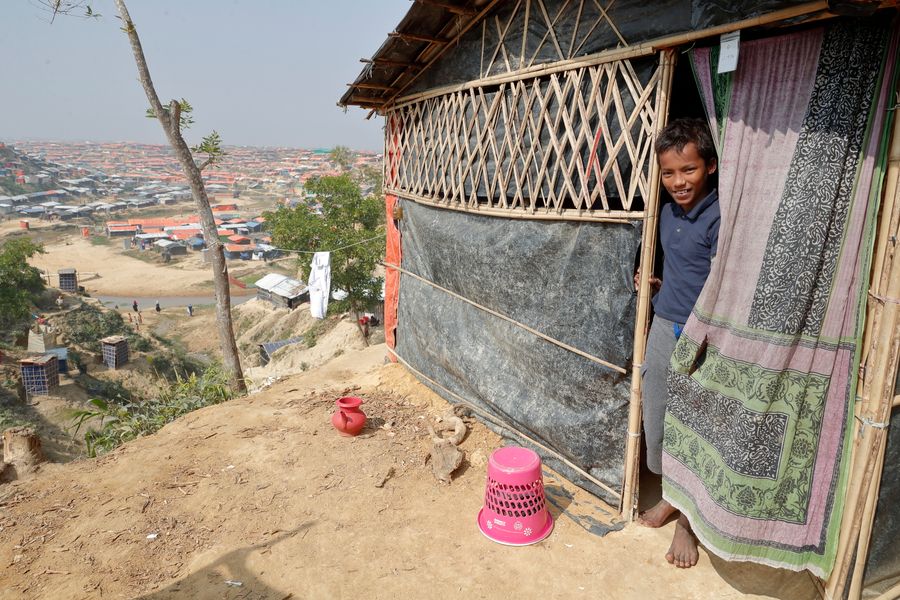
Inside the Kutupalong refugee camp, Cox's Bazar
Kutupalong, located in the coastal district of Cox’s Bazar, is currently the largest refugee camp in the world. The so-called mega camp is home to around 800,000 predominantly Rohingya refugees that have fled violent persecution in neighboring Myanmar. Kutupalong isn’t only the largest camp in the world, it is also the most densely populated and has exceeded its capacity. Most of the refugees have no adequate access to clean water, sanitary facilities, or healthcare. The impending monsoon season also poses a huge threat to thousands of Rohingya families living in makeshift shelters in the camp.
Coordination of aid in camp

Kutupalong, like many other refugee camps in the world, is co-run by the United Nations (UN) and the Bangladeshi government. In order to be able to provide rapid and effective assistance, the humanitarian organizations active in the refugee camp organize themselves under the umbrella of the UN in so-called clusters. These are groups of organizations in each of the main sectors of humanitarian action, like water, health, nutrition, hygiene, shelter etc. The organizations that operate within a cluster coordinate their activities with each other. This ensures that the people living in the refugee camp are reached as easily as possible and that there is no imbalance in the supply of relief material.
In Bangladesh, Malteser International is active in the following clusters: water, health, hygiene, and nutrition. In two medical centers we carry out medical treatments and psychosocial support for refugees who have suffered traumatic experiences. We also offer a therapeutic feeding program to restore malnourished children and nursing mothers to good health. In addition, our hygiene awareness activities help to spread knowledge on the prevention of communicable diseases in the camp.
Arrival and accomodation in camp
Upon arrival in the camp, refugees are required to register at a central location to obtain a camp ID. The ID qualifies them for relief materials, like household items. The refugees also receive a a shelter kit containing materials such as bamboo poles and plastic sheeting, afterwhich they are assigned a small area of land to build on. Because one family has to share a shelter, the scant space in these shelters allow for little privacy.
Water and Hygiene
The UN WASH (Water, Sanitation, and Hygiene) cluster in Bangladesh is responsible for the provision of water and sanitary facilities in Kutupalong refugee camp. The speed and scale of the arrival of refugees led to a severe shortage in water and sanitary facilities. Some latrines and wells were dug by refugees themselves, sometimes side by side with little or no planning. The situation has increased the risk of water-borne diseases like cholera and diarrhea. The shallow pit latrines, covered with tarpaulins supported by bamboo poles, are in no way hygienic. When they fill up, a new latrine has to be dug elsewhere. Coordinating the construction of additional sanitary facilities and maintaining existing ones is currently one of the biggest challenges in the camp.
Medical care
Many refugees in the camp are not in good health. Even before their forced displacement from Myanmar, they have suffered discrimination and exclusion. They barely had access to healthcare back in their home country. Now in the overcrowded camp, the squalid conditions are a perfect environment for the spread of diseases.
There are a number of basic health stations that treat injuries, infectious diseases, and malnutrition. In some of these health stations, pregnant women and nursing mothers receive medical care. Two of these health stations are run by Malteser International in partnership with a local non-governmental organization. An added problem is that many refugees have been traumatized by their experiences in Myanmar. Many health stations, including ours, also provide trauma care.
Because these health stations only have the very basic equipment, complicated health cases are referred to nearby clinics outside the camp. However, the health stations are not yet able to reach and care for all the refugees living in the camp. There is high demand for additional facilities, health personnel and medical equipment.
Nutrition
Refugees in the camp are meant to receive food rations amounting to about 2100 kilocalories. This is the minimum humanitarian food package required to maintain a stable nutritional status. The rations usually consist largely of rice, beans, and vegetable oil.
However, the food is not always guaranteed to reach everyone. The rations are also usually lacking in essential vitamins and proteins that can only be provided by additional vegetables, fruits, fish or meat. Since refugees are neither allowed to cultivate their own food in the camp nor permitted to work in Bangladesh, they have no chance of earning a living, and are completely reliant on external assistance provided by relief organizations.
A large number of Rohingya, especially children, pregnant and nursing women, arrived Bangladesh already malnourished. While in Myanmar, they faced severe poverty as a result of decades of discrimination and could hardly provide enough food for themselves and their families. The journey to Bangladesh has also taken its toll on their health – many had to walk for days with little or no food. We are treating acute malnutrition in children and mothers through our therapeutic feeding program. Yet, the magnitude of the challenge remains daunting. There are more cases of malnutrition than there are programs to address them. Sadly, we are currently lacking the financial resources to expand our program to reach even more people.
An impending disaster
Bangladesh has a tropical monsoonal climate characterized by heavy seasonal rainfall – a cyclone season beginning in March, and monsoon rains from June to October. Approximately 80% of the country’s yearly rainfall occurs in the months between June and October.
The location of the Kutupalong camp along the coast makes the camp highly prone to violent cyclones. Most of the shelters in the camp have been built on and around steep, sandy hills that were once forests. Not only is the soil sandy, the vegetation in the area has also been stripped off in the past months to provide shelter and firewood for the refugees. As there are hardly any trees left, the monsoon rainfalls could erode the soil and bring devastating landslides – a very troubling prospect for many Rohingya families living in makeshift shelters.
Our health stations in the camp will also be at risk of landslides, and could be flooded in the torrential rains. That is why securing the health stations is top priority for us.








